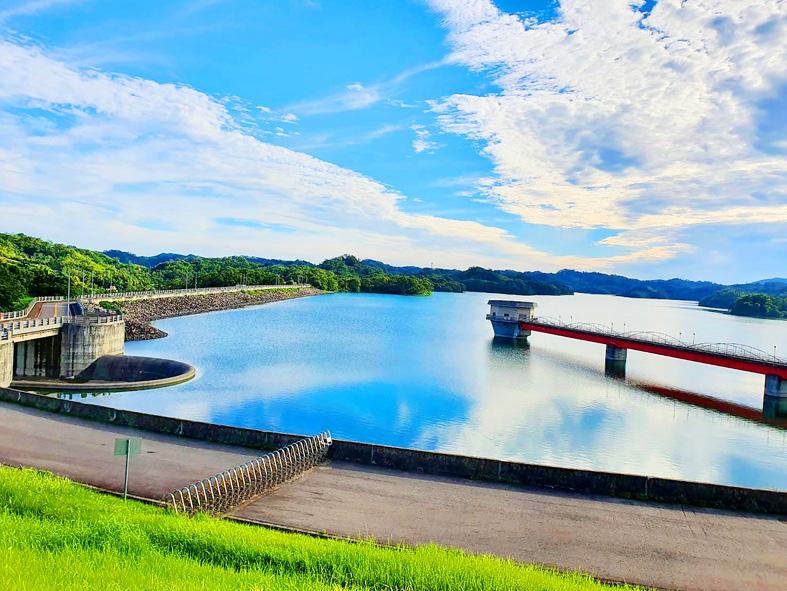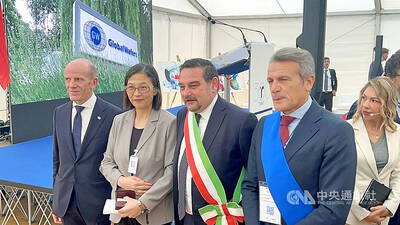Baoshan Second Reservoir (寶二水庫), which supplies water to the Hsinchu Science Park (新竹科學園區), yesterday morning reached full capacity for the first time since June 22 last year, the Water Resources Agency (WRA) said.
Earlier this year, the water level was extremely low at Hsinchu County’s Baoshan Reservoir (寶山水庫) and the nearby Baoshan Second Reservoir, as no typhoons made landfall last year, resulting in much less rain in the second half of the year, which was exacerbated this year by less spring rain than usual and a late start of the plum rain season.
Baoshan Second Reservoir had 10.31 million cubic meters of water earlier this year, but the level fell precipitously, hitting a record low of 822,000 cubic meters, or 2.6 percent of capacity, on May 30, WRA data showed.

Photo courtesy of Chiu Wen-lang
The arrival of a plum rain front on May 30 brought significant rainfall to the reservoir over the next several days, allowing the Ministry of Economic Affairs to end water rationing measures for the Hsinchu area on Wednesday last week, the agency said.
From May 30 to Wednesday last week, the water level at the reservoir rose from nearly empty to almost full capacity thanks to the heavy rain brought by the weather front, it said.
Separately, the agency said that lower water levels in the past several months have allowed for reservoir dredging and storage capacity improvement.
Based on the agency’s latest data, dredging at the nation’s reservoirs this year has removed 11.11 million cubic meters of sediment, the highest for the same period on record and about twice the annual average of 5.64 million cubic meters, it said.
The government dredged 14.4 million cubic meters of sediment from reservoirs last year, the most on record, and aims to remove 15.22 million cubic meters of silt and sand this year, the agency said.
The removal of 25.51 million cubic meters of sediment at reservoirs since last year is equivalent to 5.5 times the amount of sediment cleared out of Tainan’s Zengwen Reservoir (曾文水庫), the nation’s largest reservoir, it said.
Last year, 4.62 million cubic meters was dredged from Zengwen, accounting for 30 percent of the total dredging in Taiwan’s reservoirs, the agency said.

RECYCLE: Taiwan would aid manufacturers in refining rare earths from discarded appliances, which would fit the nation’s circular economy goals, minister Kung said Taiwan would work with the US and Japan on a proposed cooperation initiative in response to Beijing’s newly announced rare earth export curbs, Minister of Economic Affairs Kung Ming-hsin (龔明鑫) said yesterday. China last week announced new restrictions requiring companies to obtain export licenses if their products contain more than 0.1 percent of Chinese-origin rare earths by value. US Secretary of the Treasury Scott Bessent on Wednesday responded by saying that Beijing was “unreliable” in its rare earths exports, adding that the US would “neither be commanded, nor controlled” by China, several media outlets reported. Japanese Minister of Finance Katsunobu Kato yesterday also

‘DRAMATIC AND POSITIVE’: AI growth would be better than it previously forecast and would stay robust even if the Chinese market became inaccessible for customers, it said Taiwan Semiconductor Manufacturing Co (TSMC, 台積電) yesterday raised its full-year revenue growth outlook after posting record profit for last quarter, despite growing market concern about an artificial intelligence (AI) bubble. The company said it expects revenue to expand about 35 percent year-on-year, driven mainly by faster-than-expected demand for leading-edge chips for AI applications. The world’s biggest contract chipmaker in July projected that revenue this year would expand about 30 percent in US dollar terms. The company also slightly hiked its capital expenditure for this year to US$40 billion to US$42 billion, compared with US$38 billion to US$42 billion it set previously. “AI demand actually

Jensen Huang (黃仁勳), founder and CEO of US-based artificial intelligence chip designer Nvidia Corp and Taiwan Semiconductor Manufacturing Co (TSMC, 台積電) on Friday celebrated the first Nvidia Blackwell wafer produced on US soil. Huang visited TSMC’s advanced wafer fab in the US state of Arizona and joined the Taiwanese chipmaker’s executives to witness the efforts to “build the infrastructure that powers the world’s AI factories, right here in America,” Nvidia said in a statement. At the event, Huang joined Y.L. Wang (王英郎), vice president of operations at TSMC, in signing their names on the Blackwell wafer to

Taiwan-based GlobalWafers Co., the world’s third largest silicon wafer supplier, on Wednesday opened a 12-inch silicon wafer plant in Novara, northern Italy - the country’s most advanced silicon wafer facility to date. The new plant, coded “Fab300,” was launched by GlobalWafers’ Italian subsidiary MEMC Electronics Materials S.p.A at a ceremony attended by Taiwan’s representative to Italy Vincent Tsai (蔡允中), MEMC President Marco Sciamanna and Novara Mayor Alessandro Canelli. GlobalWafers Chairwoman Doris Hsu (徐秀蘭) said the investment marked a milestone in the company’s expansion in Europe, adding that the Novara plant will be powered entirely by renewable energy - a reflection of its